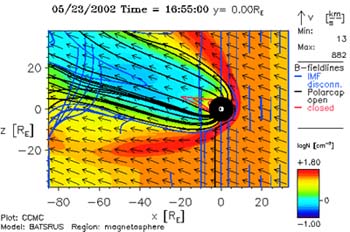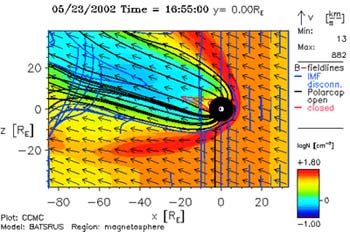Quoted from: https://ccmc.gsfc.nasa.gov/models/modelinfo.php?model=BATS-R-US
Model Description
 BATS-R-US, the Block-Adaptive-Tree-Solarwind-Roe-Upwind-Scheme, was developed by the Computational Magnetohydrodynamics (MHD) Group at the University of Michigan, now Center for Space Environment Modeling (CSEM). It was designed using the Message Passing Interface (MPI) and the Fortran90 standard and executes on a massively parallel computer system.
BATS-R-US, the Block-Adaptive-Tree-Solarwind-Roe-Upwind-Scheme, was developed by the Computational Magnetohydrodynamics (MHD) Group at the University of Michigan, now Center for Space Environment Modeling (CSEM). It was designed using the Message Passing Interface (MPI) and the Fortran90 standard and executes on a massively parallel computer system.
The BATS-R-US code solves 3D MHD equations in finite volume form using numerical methods related to Roe's Approximate Riemann Solver. BATSRUS uses an adaptive grid composed of rectangular blocks arranged in varying degrees of spatial refinement levels. The magnetospheric MHD part is attached to an ionospheric potential solver that provides electric potentials and conductances in the ionosphere from magnetospheric field-aligned currents.
The BATS-R-US model is now part of the Space Weather Modeling Framework (SWMF).
BATS-R-US request runs for the magnetosphere are now executed using SWMF/GM (coupled with SWMF/IE).A SWMF run of the magnetosphere at CCMC can include the Rice Convection Model (RCM) in the inner magnetosphere (SWMF/IM) in addition to the BATS-R-US MHD module of the global magnetosphere (GM) and the ionospheric electrodynamics (IE) potential solver.
If a SWMF/(BATSRUS + RCM)run is requested, the RCM modifies the plasma pressure distribution in the inner magnetosphere and changes the resulting field-aligned currents in the ionosphere (yields more realistic Region-1 currents). The RCM inside SWMF does not generate any outputs.
Model Input
nputs to BATS-R_US are the solar wind plasma (density, velocity, V_x, V_y, V_z, temperature) and magnetic field (B_x, B_y, B_z) measurement, transformed into GSM coordinates and propagated from the solar wind monitoring satellite's position propagated to the sunward boundary of the simulation domain. The Earth's magnetic field is approximated by a dipole with updated axis orientation and co-rotating inner magnetospheric plasma or with a fixed orientation during the entire simulation run. The orientation angle is updated according to the time simulated or a fixed axis position can be specified independently from the time interval that is simulated.
Model Output
Outputs include the magnetospheric plasma parameters (atomic mass unit density N, pressure P, velocity V_x, V_y, V_z, magnetic field B_x, B_y, B_z, electric currents, J_x, J_y, J_z) and ionospheric parameters (electric potential PHI, and Hall and Pedersen conductances Sigma_H, Sigma_P).
Relevant links
CCMC Contact(s)
Masha Kuznetsova
301-286-9571
Developer Contact(s)
Tamas Gombosi



 BATS-R-US, the Block-Adaptive-Tree-Solarwind-Roe-Upwind-Scheme, was developed by the Computational Magnetohydrodynamics (MHD) Group at the University of Michigan, now Center for Space Environment Modeling (CSEM). It was designed using the Message Passing Interface (MPI) and the Fortran90 standard and executes on a massively parallel computer system.
BATS-R-US, the Block-Adaptive-Tree-Solarwind-Roe-Upwind-Scheme, was developed by the Computational Magnetohydrodynamics (MHD) Group at the University of Michigan, now Center for Space Environment Modeling (CSEM). It was designed using the Message Passing Interface (MPI) and the Fortran90 standard and executes on a massively parallel computer system.




